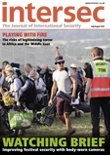Service resumed
Bernardo Chernitzky explains why, following COVID, personnel training is still the foundation of aviation security
There are few industries that needed the relaxation of Covid-19 travel restrictions as much as the aviation sector – and few that have struggled as much since they were subsequently lifted. Throughout 2022, we saw airports and carriers around the world scrambling to get back to full capacity – and capability – following an enforced hiatus that has left the industry out of practice, resources and answers.
In January 2022, monthly international passenger numbers at UK airports stood at roughly 5.8-million. By May, this had increased to 17.9-million. Heathrow alone experienced a 675 percent increase in passenger numbers in March 2022 compared with the same time last year, and this summer had to scramble to hire 12,000 new staff members in order to try and reach full capacity. However, the workforce has been drained and depleted through a combination of labour force shortages in the aviation sector, inadequate skills training and remuneration and the associated inability to retain and attract experienced workers.
Something has to give, and there is a risk that the drive to improve passenger flows, chiefly by moving passengers through screening areas more quickly, will see attention and security staff drawn away from other important responsibilities, including in detection and deterrence. At the very least, security risks becoming an area of complacency.
At London Stansted Airport in the UK – for example, run by operator Manchester Airports Group – the facility lost around half of its trained security staff to voluntary redundancy over the course of the pandemic. This is being mainly felt by passengers who have been left miserable and out of pocket due to impossible lines and luggage mountains. But it is also hurting airports’ and carriers’ bottom lines, not to mention their reputations. At Heathrow, British Airways reportedly cut around 10,000 flights between October and March 2023 due to the fact that the airport is no longer equipped to handle this through flow of people. Recruitment is just the starting point. Although the industry will likely find ways to patch things up in time for the summer rise in passenger numbers, it is a long way from addressing the underlying problems in security staffing and procedures. By backing this up with high-quality personnel training the industry can begin to resolve some of these concerns.
What we see in the security industry in general is a trend to replace personnel with technology, but the Israeli airline security model exemplifies the idea that balancing advanced technology with highly skilled personnel is the way to success. Having spent nearly a decade implementing advanced security measures for the Israeli airline industry, first for the Israel Airport Authority and then for Israel’s national carrier El Al, I have seen the value of this first hand. Despite the high input costs associated with training, I want to make the case for how personnel training actually offers the most bang for every buck of any business strategy and why international peers would do well to adopt this strategy for success from their Israeli counterparts.
It is easy to see why airports around the world have long tried to emulate the record of Israeli aviation security. Its history of successfully preventing attacks, bearing down on crime and smuggling, and establishing an excellent culture of safety and diligence provides an international benchmark. In fact, since the 1972 attack on Ben Gurion International Airport, which left 26 dead and 80 more injured, there has been no further major loss of life, despite the fact that the airport is situated in one of the most volatile regions globally.
Airports around the world have naturally tried to emulate this record. Yet, previous attempts to replicate Israeli aviation security elsewhere have focused on hard preventative measures such as implementing a series of security circles around the airport, which just adds progressive layers of observation and screening from arrival at the airport site through to departure. The complexity and price of implementing the entire Israeli security strategy means it is clearly not a viable, cost-effective or even proportionate solution – especially given the lower level of risk found elsewhere in the world.
This time, we should look beyond the eye-catching, hard preventative measures – impractical and unnecessary in the UK context – to see what really underpins the success of the Israeli sector: the excellent standards of personnel. This is, of course, partly a product of the large pool of ex-military service people to be found in Israel, but it is equally a result of the attention to regular, rigorous and high-quality training, something that can be replicated by airports in the UK and internationally.
The first lesson from the Israeli industry is that nothing can make up for deficiencies in personnel training when it comes to security and safety. There is no scanner on the market, no risk mitigation strategy yet conceived, that can replicate the ability of a well-trained security officer. That is not to say that airports do not need to continue to invest in the most up-to-date and advanced technologies to assist these officers – but they should think carefully about whether this leads to training being overlooked. Investment in technology extends beyond up-front costs to the maintenance, repairs, upgrades and – dare I say it – personnel training required to keep these complex systems working and functioning to the very best of their potential.
Indeed, as technology becomes more sophisticated the general rule of thumb is that it becomes correspondingly more difficult to operate and requires correspondingly more sophisticated training to make full use of it. If much of the same capability can be obtained through improved training methods and programmes at a similar – or even lower price point – then it makes sense for over stretched airports to concentrate resources here first.
The investment in training can also help airports to square the circle on their investments in technology, not only by allowing operators to use it more effectively, but also by streamlining the flow of information through the airport. For example, monitoring plays a vital role in keeping an airport on alert and constantly learning. Yet not all data can be collected automatically. The best insights still come from highly trained and motivated staff who know the importance of investing time collecting, collating and investigating data. This shows in the Israeli industry, where security personnel are highly trained in identifying suspicious behaviour, this is a foundation of aviation security in Israel. Furthermore, they are trained at questioning and performing field interviews at a high level in airport grounds. All of this allows Israeli security to mitigate risks before they reach their intended targets, and reduces pressure and risk on the passenger screening process. It also creates a recognisable ‘brand’ for Israeli aviation security that acts as a further deterrent to adversaries and evolving threats. Human adaptability is the ultimate trump card over technology – and training is key to unlocking this.
Ultimately, there is simply no getting away from the need for expert human staff to operate these top-of-the range scanners and threat-detection systems, and put their findings into action. The Israeli industry recognises that the human touch should still lie at the heart of security. A hypothetical AI-enhanced facial recognition algorithm might be able to identify suspicious behaviour on the airport concourse, but this is useless unless there is a human operative present who knows the proper procedure for dealing with the specific threat, can decide on the best course of action and has the requisite skill to handle a crowded public space with calm and assurance so as to not provoke a panic.
In the search for new efficiencies in security systems, some are tempted to single out proper planning as the cure, but this imagined scenario also shows that it too – like technology – can only get you so far. Planning is an indispensable part of the security approach, but it is only part of it and needs to be backed up by proper learning and development protocols. Personnel training, coupled with regular validation and testing of this training, is the only way for airports to transform security protocols and standard operating procedures into organisational muscle memory, equipping their security staff with the skills and confidence to respond well to high-pressure situations. Unless you can turn plans into action at a moment’s notice, even the most well thought-out and comprehensive risk management and planning become just words on a page.
Nor should we think of building up the skills and confidence of our security personnel as an isolated investment. The gains will be felt across the airport facility. Highly trained staff also pull up the confidence and competency of those around them, giving team members greater confidence to respond to crises. This occurs regardless of whether the trained staff are working with another security officer who has just started, or an airport employee working on another area entirely – everyone benefits from the additional feeling of security, professionalism and pride that personnel training brings. Airports worried about improving operational efficiency across their facility should factor in this multiplier effect of personnel training when making spending decisions.
In this way, more and better personnel training for security staff can start to address the industry’s problems with staff retention and morale too. In a world where short-term employment is the default, studies consistently show that personal development opportunities are a determining factor in employee retention. Investing in this area now can help to create a long-term stock of highly skilled and motivated workers and by bringing down turnover even slightly, airports can actually start to see cost efficiencies when it comes to up-front training. Rather than providing a steady stream of onboarding training, they would be able to turn their attention to more sophisticated training areas and programmes, bringing up the skills, morale and professionalism of their workforce and ultimately making the airport a more stimulating and satisfying place to work.
It is to avoid a repeat of the scenes that we saw over last summer that I urge airport operators to learn this lesson from the Israeli industry, which has long been considered a gold standard in aviation security. In particular, the sector points to the vital importance of improved security personnel training and development, which if implemented elsewhere – even in part – would provide an invaluable force multiplier in the arsenal of airports in the year ahead and beyond. Failure to do so could be catastrophic, while doing so offers only upsides.
Bernardo Chernitzky, Director of Operations TF Consultancy Group, has over 16 years’ operational experience, with specific expertise in aviation security best practices from his time serving as a Federal Air Marshal in Israel and implementing advanced security measures for both the Israel Airport Authority and El Al.









